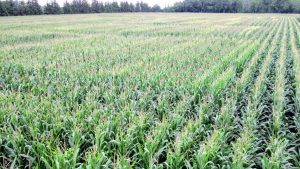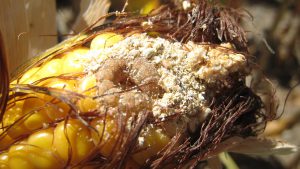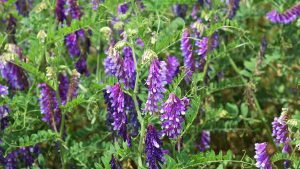Weed resistance management
WATERHEMP, CANADA FLEABANE, AND EMERGING ISSUES

MANAGING WEEDS IN Ontario farm fields is becoming more of a challenge due to herbicide resistance. Research is being conducted to find viable solutions.
SEEDS BY THE MILLIONS
A new waterhemp seed count helps explain why this invasive weed has taken hold in Ontario — and why controlling it is such a challenge.
In 2017, Peter Sikkema of the University of Guelph Ridgetown Campus embarked on a nine-year study to develop a diversified, integrated weed management strategy for multiple-herbicide-resistant waterhemp control in corn, soybeans, and winter wheat.
From its initial, isolated discovery in Ontario around 2000 near Petrolia — suspected to have arrived on a waterhemp-contaminated combine from Illinois — this weed has gone on to become one of our farmers’ biggest problems.
In 2014, glyphosate-resistant waterhemp was found on Walpole Island and has been confirmed in a dozen more counties. Research shows average yield loss from this weed is 17 per cent in corn and 43 per cent in soybeans.
A first step for Sikkema was to determine how many waterhemp seeds were present in the test plots on two commercial farms, one near Cottam, and the other on Walpole Island. That way, he could later understand the effectiveness of the control strategies he will be developing, by counting the seeds present in fields that get treated.
He didn’t know what to expect. But the numbers he found were staggering: 165 million seeds per acre in the Cottam plots and 16 million seeds per acre in the Walpole Island plots.
“Those are huge numbers,” says Sikkema. “We had never done this kind of a study and I didn’t expect to find this many seeds. This is what some farmers face before they even start planting.”
Sikkema’s nine-year study has a goal to deplete that seed by 95 per cent, using currently available technology and equipment.
His study includes a variety of approaches. These include continuous soybean, two-crop rotations (corn-soybean and soybean-wheat) and three-crop rotations (corn-soybean-wheat and corn-soybean-wheat and cover crop), narrow 15-inch rows in soybean, and the use of efficacious herbicides.
In the most diverse crop rotations, Sikkema will use 10 different herbicide active ingredients — dicamba, atrazine, bromoxynil, glyphosate, flumioxazin, pyroxasulfone, s-metolachlor, mesotrione, bicyclopyrone, and pyrasulfotole — from seven herbicide groups (4, 5, 6, 9, 14, 15, and 27) over a three-year period.
Sikkema says that at both the Cottam and Walpole Island test sites, near-perfect multiple-herbicide-resistant waterhemp control has been achieved in corn, soybean, and wheat when integrated weed management practices were implemented. Further results will be released in 2021, when seed density is determined following the first three-year cycle of the corn-soybean-wheat rotation in this study.
Meanwhile, to help control multiple-herbicide-resistant waterhemp in a corn-and-soybean rotation, Sikkema recommends that farmers consider a two-pass weed-control program.
He says to start with an effective soil-applied herbicide, such as Acuron or Integrity for corn, and Fierce, TriActor, Authority Supreme, Boundary or Bifecta for soybean. Then, follow with a post-emergence herbicide if needed, such as Acuron, Shieldex + atrazine, Converge + atrazine, Callisto + atrazine, Enlist or dicamba for corn; Reflex, Blazer or Hurricane for IP or RR soybean, Enlist Duo for Enlist soybean, and dicamba or Tavium for Xtend soybeans.
Overall, he says an integrated approach that includes herbicides — but not exclusively — is best.
“As Dr. Andrew Kniss of University of Wyoming states, at some point, we need to stop looking to herbicides as the solution to a problem created by herbicides,” he says.
HERBICIDE STRATEGIES
Glyphosate-resistant Canada fleabane can be another costly problem to have on your farm. But research conducted by Sikkema shows that greater than 90 per cent control is possible. He launched an on-going research project a decade ago when the first glyphosate-resistant weed biotype was identified in Ontario.
“The results from this research will provide Ontario grain farmers with new knowledge to improve the management of glyphosate-resistant Canada fleabane on their farms.”
For glyphosate-resistant Canada fleabane control in corn with herbicides applied preplant, Acuron Flexi, Callisto + atrazine and Shieldex + atrazine controlled Canada fleabane 91 to 95 per cent. The most efficacious herbicides were Acuron, Integrity, and Lumax at 98 per cent control.
Callisto + atrazine, Pardner + atrazine and Shieldex + atrazine applied post-emergence in corn, controlled glyphosate-resistant Canada fleabane 90 to 94 per cent. The most effective herbicides were Distinct, dicamba (high labelled rate), and Lontrel at 96 to 99 per cent control.
Glyphosate-resistant Canada fleabane was controlled 54 per cent with BlackHawk applied preplant in soybean. Control improved to 91 per cent with the addition of metribuzin. Elevore controlled glyphosate-resistant Canada fleabane 67 per cent; the addition of metribuzin or Eragon improved control to 93 to 94 per cent. Eragon, applied preplant in soybean, controlled glyphosate-resistant Canada fleabane 85 per cent; the addition of Elevore or metribuzin improved control to 94 per cent.
For glyphosate-resistant Canada fleabane control in Roundup Ready Xtend soybean, dicamba, applied PP, at the low, medium, and high rate provided 78, 87, and 91 per cent, respectively. The addition of Elevore, BlackHawk, 2,4-D, or Eragon improved control to 94 to 98 per cent.
Enlist Duo, applied preplant, controlled glyphosate-resistant Canada fleabane 57 per cent in Enlist soybean. Adding metribuzin or Eragon improved control to 93 to 96 per cent.
For glyphosate-resistant Canada fleabane in wheat the most effective herbicides were Infinity, Pixxaro + MCPA, and Lontrel at 93 to 96 per cent control.
For multiple-herbicide-resistant waterhemp in corn, these approaches were effective:
- Acuron Flexi, Lumax, Primextra, Callisto + atrazine and Converge + atrazine, applied pre-emergence, in corn provided 82 to 89 per cent control; the most effective herbicides were Integrity and Acuron at 91 and 95 per cent, respectively.
- Callisto + atrazine, Converge + atrazine, Shieldex + atrazine and Acuron Flexi, applied post-emergence in corn controlled multiple-herbicide-resistant waterhemp 91 to 92 per cent; Acuron controlled waterhemp the best, at 96 per cent.
- In soybean, Bifecta, Boundary, Valtera and Authority Supreme, applied pre-emergence controlled waterhemp 81 to 84 per cent; the most effective herbicides were TriActor and Fierce at 90 to 92 per cent control.
Sikkema recommends a planned two-pass waterhemp control program in soybean. He suggests that farmers use one of the aforementioned herbicides applied pre-emergence, then be prepared to apply Blazer, Reflex, or Hurricane post-emergence in IP or RR soybean, Enlist Duo postemergence in Enlist soybean, and dicamba or Tavium in Xtend soybean.
Sikkema urges applicators to use extreme caution when applying dicamba based herbicides post-emergence in Xtend soybean. “I’ve visited too many fields with injury to sensitive crops in adjacent fields due to off-target-movement of dicamba,” he says.
EMERGING WEED ISSUES
There are several other emerging weed management issues Sikkema is working to address.
Metribuzin-resistant waterhemp
On January 1, 2019 one field in Ontario was confirmed and 16 months later, the resistant plant was found in 12 fields in three counties (Essex, Lambton, and Middlesex).
David Westerveld, a MSc student working with Sikkema, conducted 10 field trials (five trials with metribuzin-sensitive plants and five trials with metribuzin-resistant plants) over a two-year period (2019, 2020) to determine the biologically effective dose of metribuzin for the control of metribuzin-resistant waterhemp.
Metribuzin, applied pre-emergence at 560 g/ha, controlled metribuzin-sensitive water hemp at 94 per cent. But it hardly touched the resistant waterhemp, achieving only three per cent control.
As well, waterhemp with resistance to both atrazine and metribuzin is present in at least three Ontario counties. Based on preliminary field trials with metribuzin, applied pre-emergence, this mechanism of resistance has a resistance factor of approximately 34. With metribuzin, applied post-emergence, the resistance factor is 23.
Green pigweed
MCPA has a rating of nine for pigweed control in Publication 75. Results from seven trials conducted over a three-year period show that MCPA control a putative Group 4-resistant green pigweed biotype 26 per cent. Sikkema’s current research is focused on finding solutions in corn and soybean. Preliminary data showed effective control strategies in corn were Zidua, Callisto + atrazine, Converge + atrazine, Lumax, Acuron Flexi and Acuron (applied pre-emergence) and Marksman and atrazine, applied post-emergence.
In soybean, Bifecta, TriActor and Fierce, applied pre-emergence, provided excellent control. Flexstar GT and Roundup provided good and excellent control, respectively, of green pigweed in Roundup Ready soybean.
Crabgrass
Control of Group 1-resistant large crabgrass was less than 45 per cent with Poast, Assure, and Venture in IP soybean. However, Select, applied post-emergence, controlled this large crabgrass biotype 81 per cent.
The delayed post-emergence herbicide application in corn when weeds are five centimetres high results in a 5.5 bu/ac or $26.62/ac yield loss. When herbicide application is delayed until weeds are 10 cm in height that loss skyrockets to 16.3 bu/ac or $79.24/ac.
In soybeans, delayed post-emergence herbicide application when weeds are five centimetres in height results in a yield loss of 1.0 bu/ac or $13.37/ac; when herbicide application is delayed until weeds are 10 cm in height, losses jump to 1.5 bu/ac or $18.67/ac.
Chickweed
Refine, Refine M, Barricade M, Luxxur and Luxxur M, applied post, provided excellent control of common chickweed in winter wheat.
The Herbicide Strategies project was funded in part by several industry partners.
This article features research funded by Grain Farmers of Ontario. •

























